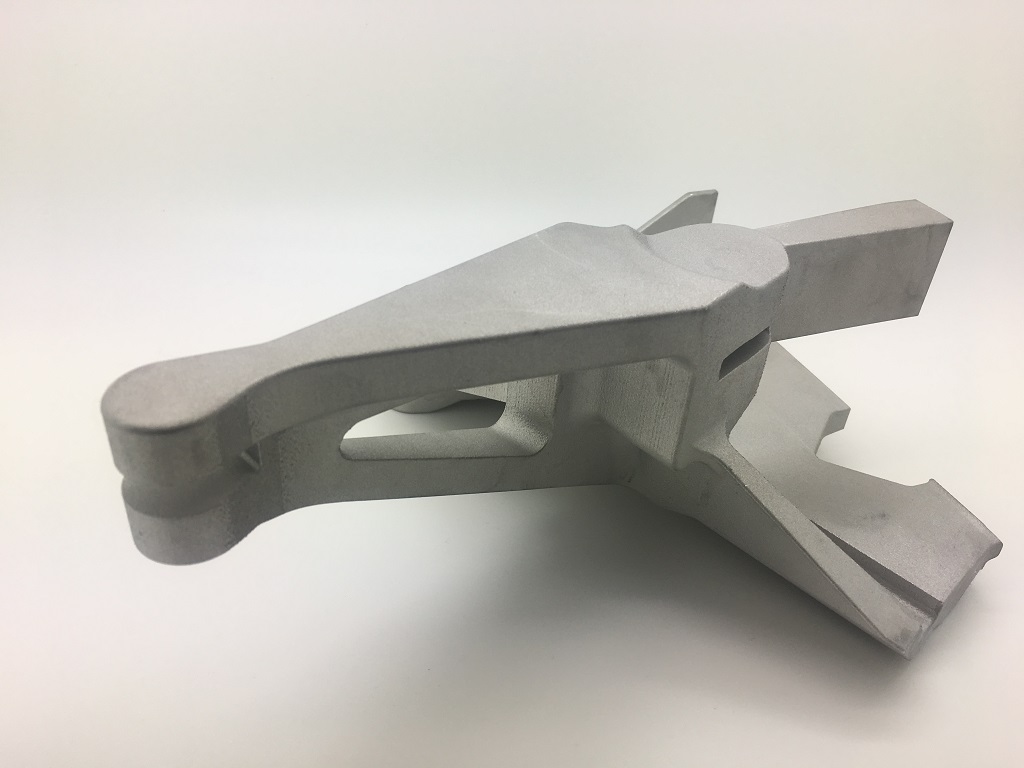![3D printed power door opening system (PDOS) bracket for the GEnx-2B engine [Image: GE Additive]](https://fabbaloo.com/wp-content/uploads/2020/05/GEAdditive_PDOSadditivebracketforGEnx-2Blight-1November2018_img_5eb0a3a527bcd.jpg)
Aviation is gaining another additive manufacturing installation.
Today, GE has announced FAA ‘change in design’ approval for a power door opening system (PDOS) bracket. FAA regulations govern the air, as it were, and such approval will see a redesigned cobalt-chrome 3D printed bracket on the GEnx-2B engine, which powers the Boeing 747-8.
The design-to-production on the bracket, the first AM part to be installed on the GEnx engine, was just a 10-month process. The speedy time-to-engine time period serves as a proof case for one of the most oft-cited benefits of additive manufacturing. It also serves as proof of the fast turnaround possible in a massive integrated operation such as that employed by GE, which saw close cooperation between the teams at GE Aviation and GE Additive.
“We chose this project because it represented several firsts for us. It’s the first program we certified on a Concept Laser machine. It’s also the first project we took from design to production in less than ten months,” said Eric Gatlin, General Manager, Additive Integrated Product Team, GE Aviation.
Mass production is set for GE Aviation’s Auburn, Alabama facility — the same that recently marked a milestone in 3D printing aviation’s poster part for AM, the famed fuel nozzle. The team will add the PDOS bracket to operations this month, and shipping is expected to begin in January 2019.
While we’re familiar with the LEAP engine housing the fuel nozzle, the GEnx is a famed engine itself; GE reports that it is “the fastest-selling, high-thrust jet engine in GE Aviation history with more than 1,600 engines on order.” Already a more efficient design compared to its predecessors — such as GE’s CF6 engine — the new bracket design is set to advance efficiencies further.
The PDOS is a ground-use system that opens and closes the fan cowl doors to allow fan compartment access for maintenance. The new bracket reduces waste by up to 90% from previous subtractive manufacturing methods, as well as a 10% weight reduction. Four brackets are to be made on each build on the Concept Laser M2 cusing machine — enough to supply one aircraft in one print job.
“To ensure the M2 cusing machines were certified to meet the strict requirements for the aerospace industry, collaboration on this program has been closer than usual with our colleagues at GE Additive,” Gatlin noted. “As we continue thinking about the many parts we can design, redesign and manufacture on GE Additive machines, I’m looking forward to putting both our teams and the technology through their paces.”
A few significant thinking points come from the bracket’s introduction.
First, the collaboration possible within the various GE teams is impressive. Putting massive resources to work is a possibility only for such a massive company, and highlights GE’s commitment to additive manufacturing, particularly in aviation. Not that that’s been in doubt, with the high-profile acquisitions of both Concept Laser and Arcam two years ago, along with the establishment of the dedicated GE Additive umbrella.
Secondly, aviation is increasingly accepting of additive manufacturing. That the FAA has given the go-ahead for this redesign indicates significant trust in additive manufacturing. While this bracket is a first for the GEnx-2B in particular, it is not an overall industry first; we’re seeing the conversation shift now from introduction to adoption. It’s a long process, and one necessitating significant conversation, but the shift is ongoing and picking up the pace.
Furthermore, as highly regulated industries continue to adapt to and actively adopt additive manufacturing in operations, we can expect to see less stringent applications rise as well. Once 3D printing has proved its mettle in qualified uses, the now tried-and-true processes become further primed for broader adoption. That door does of course swing both ways, though, as a small component like a bracket also serves to open the door to more mission-critical applications. The bracket is thus a stepping stone for expanded applications in either direction.
GE Additive will be showcasing the bracket at the fast-approaching formnext, where they will be in Hall 3.0, Stand D30.
Via GE Additive











Eric Haddad is the founder and Pilot in Command of 3DAeroventures, a Texas-based outfit specializing in 3D printed RC aircraft.